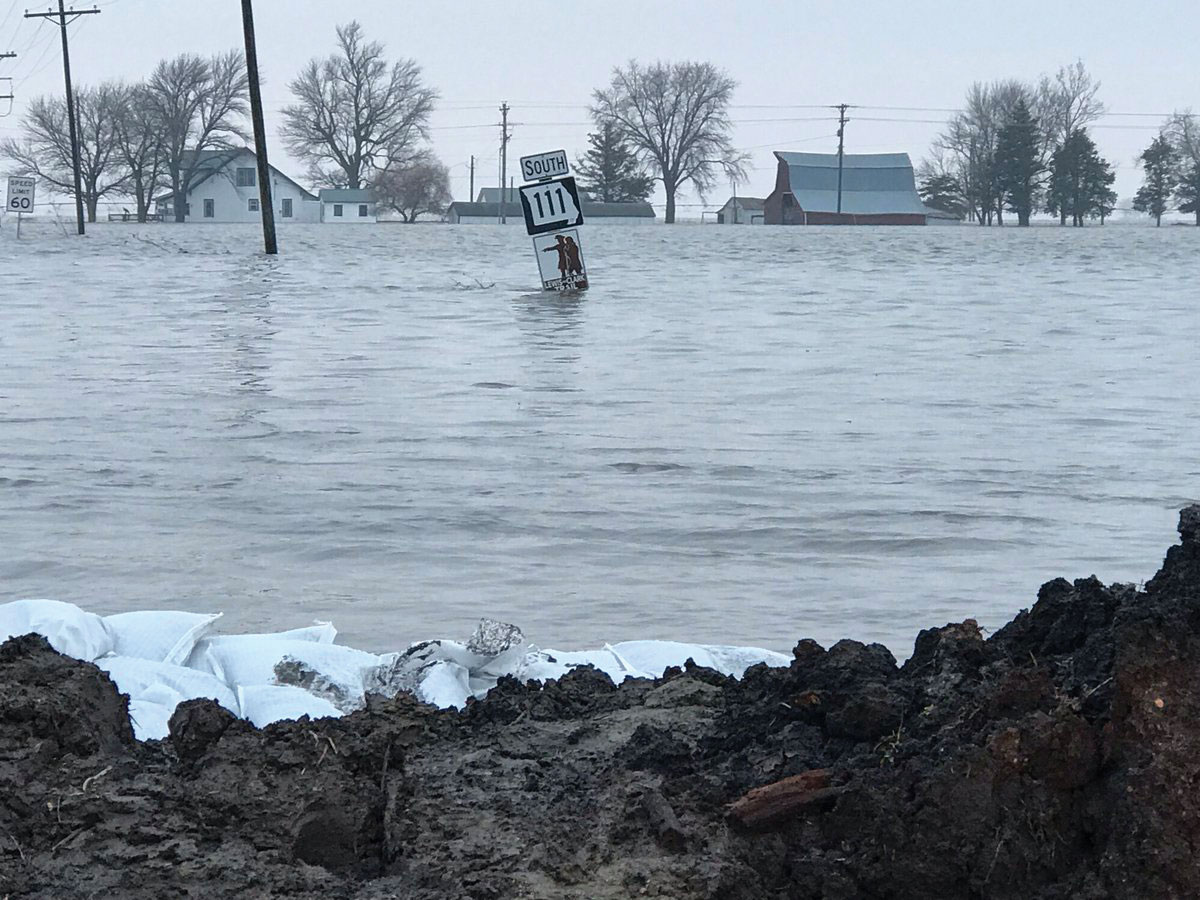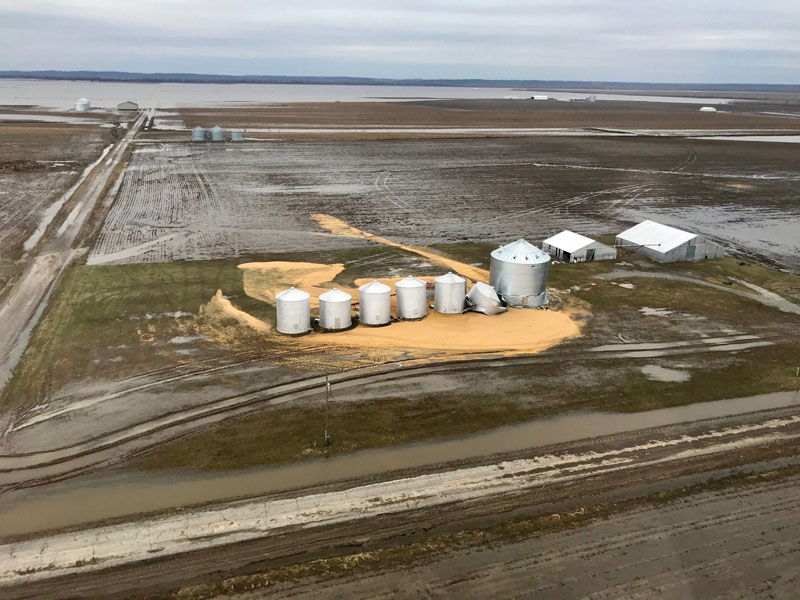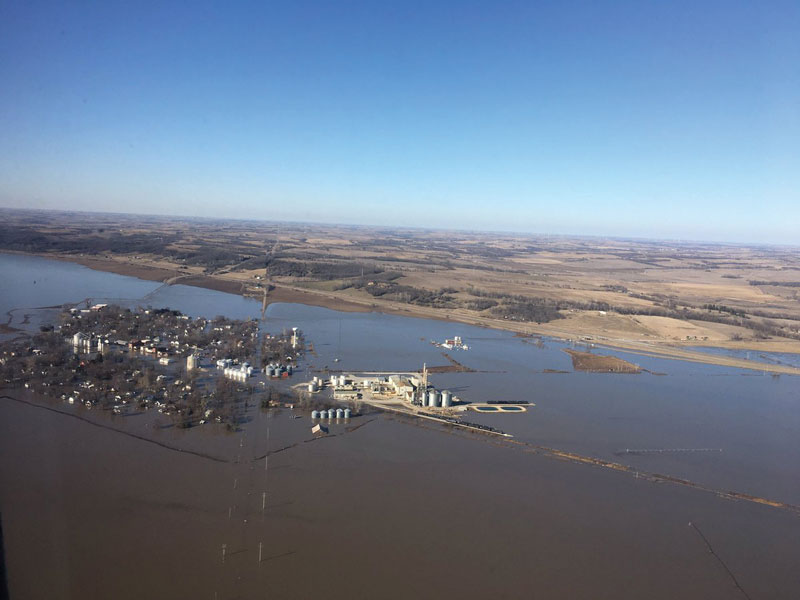
‘A Constant Nightmare’
April 12, 2019
Written By Adam Buckallew
Flooding and Questionable River Management Priorities Put Farmers in a Tough Spot
Doug Shepherd made a final attempt to harvest his stranded soybeans in mid-April, but he was forced to concede the remnants of last year’s crop were a lost cause. Shepherd’s fieldwork has been bogged down by seeping water from the nearby Missouri River since last fall, and at this point, he wonders if the fields will ever dry out and how much land he will be able to plant this spring.
“There’s about 140 acres of soybeans that have yet to be harvested, but I had to turn around when I saw the equipment was cutting two-foot-deep ruts in the field,” he says. “It’s questionable if we will be able to plant even half our acres. If we have another flood event that pushes the groundwater table any higher, it could be less than that.”
Though the catastrophic flooding that drowned large tracts of land in Nebraska, Iowa, Missouri and Kansas did not overtop or breach the levees along the Missouri River where Shepherd farms just south of St. Joseph, Mo., the persistent flood waters have taken their toll. When the waters are high, it puts pressure on the levees and drives groundwater below the earthen embankments. If seeping water flows below a levee long enough, it will begin to wash out the foundation.
“There’s a blanket of sand at the base of every levee,” explains Shepherd, who is president of the South St. Joesph Levee District. “If you start to see sand bubbling up in your field, that’s what we call a sand boil, and it can eat away at a levee and destroy everything.”
Always Pumping
A full month has passed since record-breaking floodwaters first swept down the Missouri River in March, and portions of Virgil Crockett’s farm ground near Rushville, Mo., are still swamped. He’s been busy pumping seepage water off his land and constructing sandbag rings around sand boils to prevent the levee protecting his fields from failing.
“We’re always pumping water, and the only time the pumps aren’t running is when we stop to change the engine’s oil,” Crockett says. “With the river running as high as it does these days, we are dealing with seepage that just won’t go away. It’s out of control.”
Crockett and Shepherd say the endless pumping is a massive drain on the limited financial resources of their levee districts. Crockett serves as a board member on the Halls Levee District – which protects 18,000 acres along 18 miles of the river between Rushville and St. Joseph – and says in the last year, they spent $60,000 solely on fuel to power their pumps.
“We were in a drought last year and we still pumped water all summer long because the river was running at such a high level,” Crockett says. “It never used to be like that before. Now, it’s a constant nightmare.”
Crockett expects he will be unable to plant a crop on a quarter of the acres he farms this year due to the river flowing at an average elevation of 18 feet – about a foot above its flood stage – throughout the spring and summer. He says that number would be higher if he didn’t have a fair amount of farmland on higher ground. Many of Crockett’s neighbors aren’t so lucky, including those who were inundated by the historic March flooding that breached at least 114 levees and caused an estimated $3 billion in damage along the Missouri River Basin.
“If your levee is breached, the floodwaters drop so much sand and debris on your fields that it’s hard to recover,” Crockett says. “You’ve lost that year’s potential income, and maybe the next. On top of that, you’re looking at some expensive cleanup work.”
Flood Debate
Crockett, Shepherd and other farmers say changes made to the Missouri River Master Manual in 2004 – specifically those that call for greater protection of endangered species – have led to more frequent flooding and higher river elevations. The U.S. Army Corps of Engineers is authorized by Congress to manage the river while following eight recognized objectives: flood control, navigation, hydropower, water supply, water quality, irrigation, recreation, and fish and wildlife.
The latest deluge has renewed the debate about how the Corps should prioritize those objectives.
Iowa Senator Joni Ernst hosted and chaired a field hearing of the U.S. Senate Environment and Public Works Committee on April 17 in Glenwood, Iowa, where the Corps faced hard questions about its river management practices.
“This trend of flood and rebuild, flood and rebuild must end,” Ernst told Corps officials.
“It seems to me that misguided decisions and misplaced priorities have eclipsed common sense,” remarked Senator Chuck Grassley of Iowa, who was also on hand for the hearing. “The number-one priority of the Corps should be flood control. Period.”
Earlier this spring, northwest Missouri Congressman Sam Graves introduced a bill in the U.S. House of Representatives that would remove fish and wildlife as an authorized management priority on the Missouri River and make flood control the highest priority.
The bill would require revision of the Missouri River Master Manual within 90 days of enactment.
“Time and again, we continue to see fish and birds take precedence over people and property when it comes to managing the Missouri River,” Graves said in a statement. “This latest round of flooding has devastated communities up and down the river. We already know that the management practices are contributing to it.”
Ominous Outlook
While much of the flooding that occurred in March has receded, the threat is far from over. The National Oceanic and Atmospheric Administration’s (NOAA) spring weather outlook warns the likelihood of major flooding along the Missouri and Mississippi rivers will linger for much of 2019.
“This is shaping up to be a potentially unprecedented flood season, with more than 200 million people at risk,” Ed Clark, director of NOAA’s National Water Center in Tuscaloosa, Ala., said in a news release.
Back in St. Joseph, Shepherd is all too aware of the challenges farmers and others living in the flood plain will face in the coming months.
“All the reservoirs upstream are full and there’s still a lot of snow that’s yet to melt,” he says. “I’m scared to death of what will happen. This year could make the flooding we saw in 2011 look like a cake walk.”



